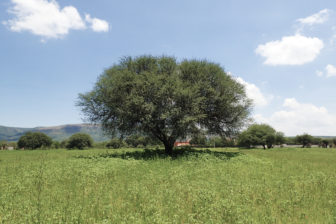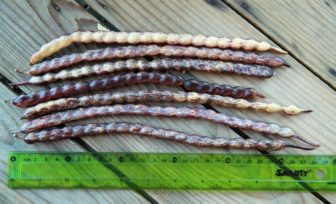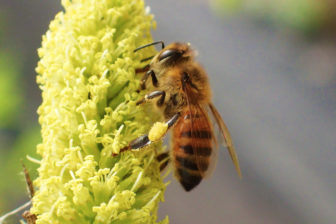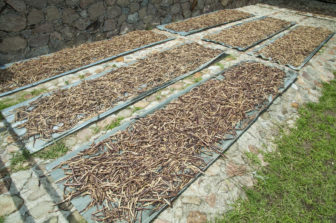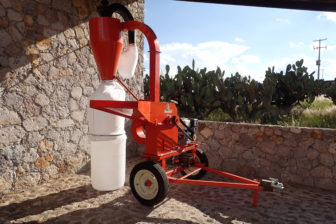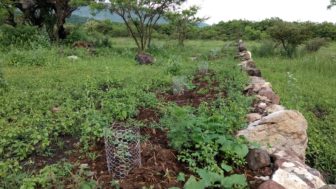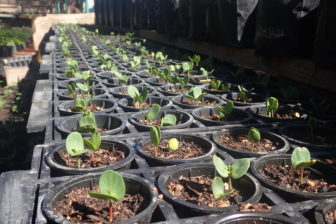What is Biochar?
Biochar technology shows promise in mitigating climate change and improving soil quality, as well as reducing waste and producing energy as a byproduct. But what exactly is biochar and what is it made of?
Biochar is a charcoal-like substance that’s made by burning organic material from agricultural and forestry wastes (also called biomass) in a controlled process called pyrolysis. Although it looks a lot like common charcoal, biochar is produced using a specific process to reduce contamination and safely store carbon. During pyrolysis organic materials, such as wood chips, leaf litter or dead plants, are burned in a container with very little oxygen. As the materials burn, they release little to no contaminating fumes. During the pyrolysis process, the organic material is converted into biochar, a stable form of carbon that can’t easily escape into the atmosphere. The energy or heat created during pyrolysis can be captured and used as a form of clean energy. Biochar is by far more efficient at converting carbon into a stable form and is cleaner than other forms of charcoal.
In terms of physical attributes, biochar is black, highly porous, lightweight, fine-grained and has a large surface area. Approximately 70 percent of its composition is carbon. The remaining percentage consists of nitrogen, hydrogen and oxygen among other elements. Biochar’s chemical composition varies depending on the feedstocks used to make it and methods used to heat it.

Photo credit: Rob Goodier/E4C
The concept of biochar is rooted in an ancient Amazonian practice
Although biochar technology is considered a more recent strategy for carbon sequestration, the practice of adding charred biomass to improve soil quality is not new. This process is modeled after a 2,000-year-old practice in the Amazonian basin, where indigenous people created areas of rich, fertile soils called terra preta (meaning “dark earth”).
Whether these soils were intentionally made or are simply a by-product of farming and/or cooking practices is still unclear. But one thing’s for sure: The fertility of terra preta is significantly higher than the otherwise famously infertile soils of the Amazon. This explains why plants grown in terra preta soil grow faster, and are more nutrient-dense, than plants grown in neighboring soils. In fact, terra preta soils continue to hold carbon still today.
How to make biochar: A closer look into biochar production
Biochar is produced during pyrolysis, a thermal decomposition of biomass in an oxygen-limited environment.
The quality of feedstocks, or materials burned, have a direct impact on the quality of the final biochar product. Ideally, clean feedstocks with 10 to 20 percent moisture and high lignin content must be used—some good examples are field residues and woody biomass. Using contaminated feedstocks, including feedstocks from railway embankments or contaminated land, can introduce toxins into the soil, drastically increase soil pH and/or inhibit plants from absorbing minerals. The most common contaminants are heavy metals—including cadmium, copper, chromium, lead, zinc, mercury, nickel and arsenic—and Polycyclic Aromatic Hydrocarbons.
Biochar can be manufactured through low-cost, small-scale production using modified stoves or kilns, or through large-scale, cost-intensive production, which utilizes larger pyrolysis plants and higher amounts of feedstocks. One of the most common ways to make biochar for on-farm use is through pyrolysis using a top-lit updraft biochar machine.
Applications of biochar in agriculture: enhancing soil and compost properties
Soil degradation is a major concern in agriculture globally. To address this burgeoning problem, researchers suggested applying biochar to degraded soils in order to enhance its quality. Some of the ways that biochar may help improve soil quality include:
- enhancing soil structure
- increasing water retention and aggregation
- decreasing acidity
- reducing nitrous oxide emissions
- improving porosity
- regulating nitrogen leaching
- improving electrical conductivity
- improving microbial properties
Biochar is also found to be beneficial for composting, since it reduces greenhouse gas emissions and prevents the loss of nutrients in the compost material. It also promotes microbial activity, which in turn accelerates the composting process. Plus, it helps reduce the compost’s ammonia losses, bulk density and odor.
How to use biochar to improve soil quality
Biochar is applied to agricultural soils using a variety of application rates and preparation techniques. The rate of application and preparation of the biochar will largely depend on specific soil conditions as well as on the materials used to make the biochar. It is often recommended to mix biochar with compost or other materials to inoculate it with nutrients and beneficial organisms.
The recommended method for applying biochar will vary depending on how healthy or nutrient-depleted your soil is. Before you use biochar in your own garden or farm, you should first consider the state of your soil. For more information on how to apply biochar on different kinds of soils, check the guidelines on International Biochar Initiative and Wakefield Biochar.
Biochar: an environmental solution
Biochar may seem like a simple material, but it can help solve a variety of global problems simultaneously. For instance, the process by which it’s manufactured may help sequester a billion tons of carbon annually and hold it in the soil for thousands of years, where it’s most beneficial.
During the production of biochar, clean and renewable energy is produced as a byproduct—this can be used as an alternative to burning fossil fuels, which has exacerbated global warming by adding greenhouse gases to the atmosphere.
Some of the other environmental benefits of biochar include decreased groundwater pollution, lower cost of water filtration, reduced amounts of waste and higher profitability for farmers. This technology also contributes to food security by increasing crop yields and retaining water in areas prone to drought.
The role of biochar in sequestering carbon and mitigating climate change
Biochar production is a carbon-negative process, which means that it actually reduces CO2 in the atmosphere. In the process of making biochar, the unstable carbon in decaying plant material is converted into a stable form of carbon that is then stored in the biochar. When biochar is applied to the soil, it stores the carbon in a secure place for potentially hundreds or thousands of years. To put it simply, the feedstocks that were used for making biochar would release higher amounts of carbon dioxide to the atmosphere if they were left to decompose naturally. By heating the feedstocks and transforming their carbon content into a stable structure that doesn’t react to oxygen, biochar technology ultimately reduces carbon dioxide in the atmosphere.
Biochar also contributes to the mitigation of climate change by enriching the soils and reducing the need for chemical fertilizers, which in turn lowers greenhouse gas emissions. The improved soil fertility also stimulates the growth of plants, which consume carbon dioxide. The many benefits of biochar for both climate and agricultural systems make it a promising tool for regenerative agriculture.
Read next: Why Regenerative Agriculture?
Click here to subscribe to Regeneration International’s newsletter.

